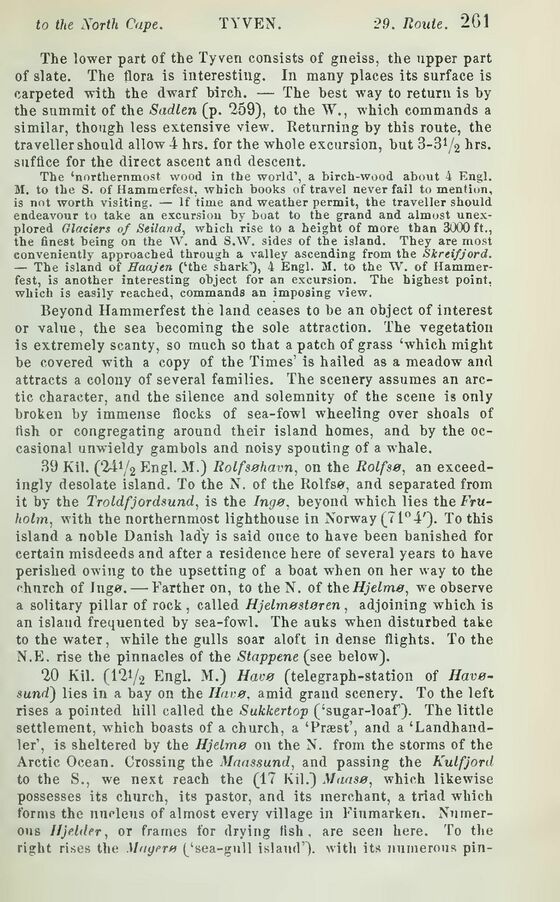
Full resolution (JPEG) - On this page / på denna sida - Norway - Pages ...

<< prev. page << föreg. sida << >> nästa sida >> next page >>
Below is the raw OCR text
from the above scanned image.
Do you see an error? Proofread the page now!
Här nedan syns maskintolkade texten från faksimilbilden ovan.
Ser du något fel? Korrekturläs sidan nu!
This page has never been proofread. / Denna sida har aldrig korrekturlästs.
The lower part of the Tyven consists of gneiss, the upper part
of slate. The flora is interesting. In many places its surface is
carpeted with the dwarf hirch. — The best way to return is hy
the summit of the Sadlen (p. 259), to the W., which commands a
similar, though less extensive view. Returning by this route, the
traveller should allow 4 hrs. for the whole excursion, but 3-3l/% hrs.
suffice for the direct ascent and descent.
The ‘northernmost wood in the world’, a birch-wood about 4 Engl.
M. to the S. of Hammerfest, which books of travel never fail to mention,
is not worth visiting. — If time and weather permit, the traveller should
endeavour to take an excursion by boat to the grand and almost
unexplored Glaciers of Seiland, which rise to a height of more than 3000 ft.,
the finest being on the W. and S.W. sides of the island. They are most
conveniently approached through a valley ascending from the Skreifjord.
— The island of Haajen (‘the shark’), 4 Engl. M. to the W. of
Hammerfest, is another interesting object for an excursion. The highest point,
which is easily reached, commands an imposing view.
Beyond Hammerfest the land ceases to be an object of interest
or value, the sea becoming the sole attraction. The vegetation
is extremely scanty, so much so that a patch of grass ‘which might
be covered with a copy of the Times’ is hailed as a meadow and
attracts a colony of several families. The scenery assumes an
arctic character, and the silence and solemnity of the scene is only
broken by immense flocks of sea-fowl wheeling over shoals of
fish or congregating around their island homes, and by the
occasional unwieldy gambols and noisy spouting of a whale.
39 Kil. (24^2 Engl. M.) Rolfsehavn, on the Rolfse, an
exceedingly desolate island. To the N. of the Rolfso, and separated from
it by the Troldfjordsund, is the Inge, beyond which lies the
Fru-holm, with the northernmost lighthouse in Norway (71°4’). To this
island a noble Danish lady is said once to have been banished for
certain misdeeds and after a residence here of several years to have
perished owing to the upsetting of a boat when on her way to the
church of Jngo. — Farther on, to the N. of the Hjelme, we observe
a solitary pillar of rock, called Hjelmesteren, adjoining which is
an island frequented by sea-fowl. The auks when disturbed take
to the water, while the gulls soar aloft in dense flights. To the
N. E. rise the pinnacles of the Stappene (see below).
20 Kil. (121/2 Engl. M.) Have (telegraph-station of
Have-sund) lies in a bay on the Have, amid grand scenery. To the left
rises a pointed hill called the Sukkertop (‘sugar-loaf). The little
settlement, which boasts of a church, a ‘Præst’, and a
‘Landhandler’, is sheltered by the Hjelme on the N. from the storms of the
Arctic Ocean. Crossing the Maassund, and passing the Kulfjord
to the S., we next reach the (17 Kil.) Manse, which likewise
possesses its church, its pastor, and its merchant, a triad which
forms the nucleus of almost every village in Finmarken.
Numerous Hjelder, or frames for drying fish, are seen here. To the
right rises the Mnyrre (‘sea-gull island’), with its numerous pin-
<< prev. page << föreg. sida << >> nästa sida >> next page >>